Mills, forests, seascapes, farms, cows, streams, sunsets: observing the beginnings of Piet Mondrian (Pieter Cornelis Mondriaan; Amersfoort, 1872 - New York, 1944), under the banner of a painting made up mainly of views and still lifes, one would hardly believe that the artist we are admiring is the same one who, just a few years later, would radically change Western art by introducing his celebrated compositions made of black lines within which the three primary colors are arranged. Mondrian’s is one of the most surprising and sudden artist’s paths in the history of art, and it took him from being an artist who was indeed talented, but not very innovative and fairly aligned with trends that had already been explored and sounded out in every direction for several years by dozens of his other colleagues, to becoming a visionary capable of rising to the status of an extraordinary protagonist of his time, a “painter-prophet” endowed with an “absolute faith in a visual language that tends to coincide with the universal rationality of reality” (as art historian Alberto Busignani defined him), to achieve which the artist, in the mature phase of his career, limited his vocabulary of forms and colors to the maximum, giving rise to the works for which he is universally known.
Mondrian’s was not a path of rupture, as might be imagined, but it was a linear process: the artist himself saw his geometric quests as being in continuity with what he had produced in the early stages of his career. In the famous Dialoog over de Nieuwe Beelding (“Dialogue on the New Plastic”), published in two issues of the magazine De Stijl (February and March 1919), Mondrian imagines a dialogue between “A,” a singer, and “B,” a painter, where the former asks the latter for enlightenment about his new art. “I admire your earlier works,” says the singer. “And because they mean so much to me, I would like to understand your current way of painting. I don’t see anything in these rectangles. What do you aspire to?” And the painter: “My new paintings have the same goals as the previous ones. They all have the same purpose, but the latest ones bring it out more clearly.” When asked what this purpose is, the painter replies, “To express relationships plastically through oppositions of color and line.” And to the singer’s objection (“but didn’t your earlier works represent nature?”), the painter replies by saying, “I was expressing myself through the means of nature. But if you look closely at the sequence of my work, you will see that it gradually abandoned the natural appearance of things and gradually emphasized the plastic expression of relationships.”
These “means of nature,” in early Mondrian, are what lead him to depict a phenomenal reality declined, however, according to those Symbolist impulses that characterize the first part of his career. A reduction of the landscape that came to him from his contacts withart nouveau (and since Mondrian focused mainly on the plant theme from the very beginning of his career, this tendency to rationalize the landscape could only have been already inherent in his art) and that, removed perhaps only from the very earliest works, already can be appreciated in some watercolors executed at the turn of the century and now in the collection of the Kunstmuseum inThe Hague (the institution that, until September 2019, was known as the “Gemeentemuseum”), which houses the world’s largest collection of Mondrian’s work (including some of his early works: it will be worth mentioning at least a Still Life from 1891 to identify a starting point). It took a few years, however, for Mondrian’s landscapes to begin to detach themselves more and more from the phenomenal plane to encounter a more pronounced tendency toward geometric scansion, which, moreover, around 1905, merged with expressionist elements that brought him surprisingly close to Munch: this is what comes to mind when we look at an image such as the Forest in Oele, a work from 1908. A surprise, since Munch, at that date, was unknown in the Netherlands (the first article devoted to the Norwegian painter would come out, in the Netherlands, only three years later). This closeness is due to the similarity of the two artists’ intentions: Mondrian, too, at this time, was trying to create a painting capable of evoking an atmosphere, an almost contemplative painting, a painting in which forms and colors translate a state.
At the time, Mondrian had been working on views of the Gein River for some time: one of these, Trees on the Gein at Dawn, from 1907-1908, is one of the key junctures in his art. Here, art historian Serge Fauchereau has written, “it is the almost monochrome that strikes the viewer, more than the strictly frontal structure: the sky, the earth, the river, everything is red, and even the dark, strong mass of trees and the discreet moon do not escape this intrusive red.” With this painting, Mondrian’s art took a further step: no longer only the structure, but also the choice of colors abandoned the sphere of perception to embrace that of intellect and subjectivity. Carlo Ludovico Ragghianti, the first Italian scholar to subject Mondrian’s art to careful and meticulous analysis, emphasized several elements that make this painting one of the cornerstones of Mondrian’s painting: the “research on the relationship between verticals and horizontals,” the “determinations where every elaborate form or mass cannot and does not want to hide the geometric skeleton,” the “ordering rhythm of the chessboard” that is “transparent here as well.”
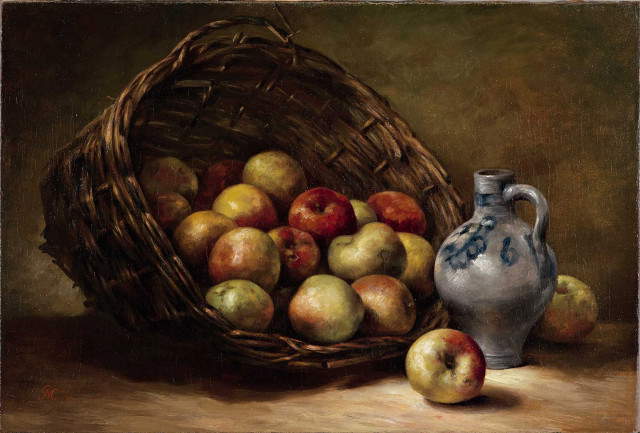 |
| Piet Mondrian, Basket with Apples (November 1891; oil on canvas, 49.5 x 72.8 cm; The Hague, Kunstmuseum Den Haag) |
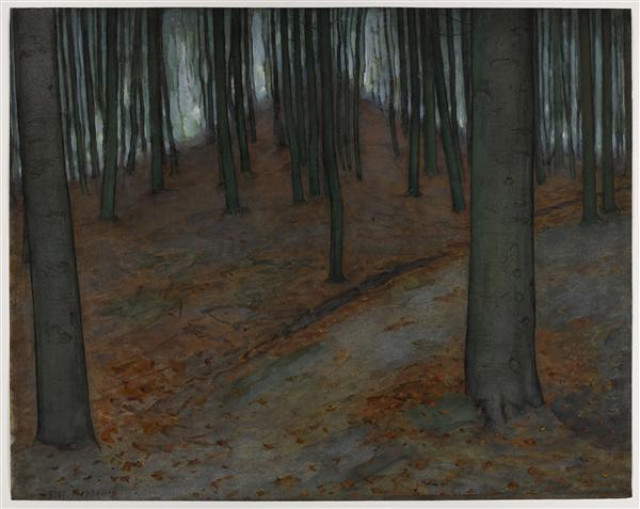 |
| Piet Mondrian, Forest (1899; watercolor and gouache on paper, 45.5 x 57 cm; The Hague, Kunstmuseum Den Haag) |
 |
| Piet Mondrian, Forest in Oele (1908; oil on canvas, 128 x 158 cm; The Hague, Kunstmuseum Den Haag) |
 |
| Piet Mondrian, Trees on the Gein at Dawn (1907-1908; oil on canvas, 79, x 92.5 cm; The Hague, Kunstmuseum Den Haag) |
It is, however, from the tree series that Mondrian’s progressive move toward geometric rigor is most tangibly inferred, acquired, moreover, within a short time: not even five years pass between paintings of a more perceptive character and those in which geometric abstraction dominates the field instead. The starting point of this quest can be identified in The Red Tree, a 1908 work painted in the coastal town of Domburg, depicting a large apple tree that occupies the entire composition. The tendency toward pure two-dimensionality is now a given: there is no depth between the branches of the large tree (which draw elaborate arabesques producing elaborate evolutions that recall certain outcomes of the very early Mondrian: this is the last time that the branches of a Mondrian tree become so intricate) and the blue evening sky over the sea, nor does the barely hinted horizon help to suggest to the viewer the distance between the different planes. And again, Mondrian proceeds swiftly on his path toward chromatic simplification, already largely initiated in Trees on the Gein at Dawn, and even more evident here. The Red Tree will be closely followed by a lesser-known work, The Blue Tree, which depicts the same plant, but with an even higher degree of abstraction, since here the knottiness and roughness of the trunk of The Red Tree are also dispensed with, and the figure of the apple tree becomes a silhouette in contrast to the sky.
The year 1911 represents a pivotal year for the artist from Amersfoort: in fact, it is the year Mondrian visits Paris for the first time: he stays for some time, determined to return (he will in fact go to live there in January 1912). In the French capital, Mondrian came into contact with the avant-garde of the Cubists, and in particular with Pablo Picasso (Malaga, 1881 - Mougins, 1973), Georges Braque (Argenteuil, 1882 - Paris, 1963) and Fernand Léger (Argentan, 1881 - Gif-sur-Yvette, 1955), all younger than him by about ten years, but able to suggest to Mondrian a fundamental lesson: the possibility of using lines and colors to get to the essence of things. Picasso and colleagues had in fact been the first, in the wake of Cézanne’s achievements, to employ pure plastic elements (colors, lines, planes) to construct volumes. Through his contact with the Cubists, Mondrian’s art lost any expressionistic or subjective connotations, but a barrier still remained that made the Dutchman incompatible with the Parisian avant-gardists: the fact that the Cubists in fact remained anchored in reality, from which, on the contrary, Mondrian intended to detach himself. The encounter is decisive, however, and the first work that results is another of the milestones of Mondrian’s career, The Gray Tree, executed in the short time Mondrian returned to Holland before moving permanently to Paris in 1912 (where he stayed for two years and, following a further Dutch interlude that lasted until 1919, Mondrian returned to Paris in 1919 where he resided for nineteen years, until 1938, before his final move, first to London and then to New York). In this painting, the subject is further reduced to its essentiality: there are still links to reality painting, but Mondrian begins to sever the links sharply. We also notice this because, for the first time, there is continuity between the tree and the background: the branches of the tree, proceeding upward, fade and almost give the impression of blending with the clouds, and as the height increases, the curvilinear shape of the branches tries to take on an increasingly horizontal course, as if the sections of circumference had to be bent to become straight (a result that Mondrian would arrive at a few years later, also eliminating the curved element from his compositions).
The last step toward Mondrian’s “cubist turn” is the Apple Tree in Bloom of 1912: the tree here becomes a set of geometric shapes and planes that recall the various fragments of which the plant is composed. The trunk is still the element around which all the parts of the tree are arranged, but it takes on a more evident geometric structure, it can no longer hold them together (branches and leaves become detached: it is a further conquest toward an art capable of untying itself from perception) and it becomes even more the central fulcrum of the composition, characterized by its vertical form on which the branches and leaves are grafted, albeit more freely. Also not to be overlooked is the fact that the trunk acquires a much more earthy hue than that of theGray Tree: a sign of Mondrian’s marked closeness to Picasso at this stage. Two years later, the Dutch artist would provide a kind of summary to explain the path that had led him to that point: “If for a long time one has loved the surface of things, one will eventually seek something new. The interiority of things is revealed through the surface, so the image is formed in our souls through the way we look at the surface. This is the image we should represent. Because the natural surface of things is beautiful, but its imitation is lifeless. Art stands higher than reality and has no direct relationship with reality. Between the physical sphere and the spiritual sphere there is a barrier where our senses stop working. The spiritual penetrates the real.”
 |
| Piet Mondrian, Red Tree (1909; oil on canvas, 70 x 99 cm; The Hague, Kunstmuseum Den Haag) |
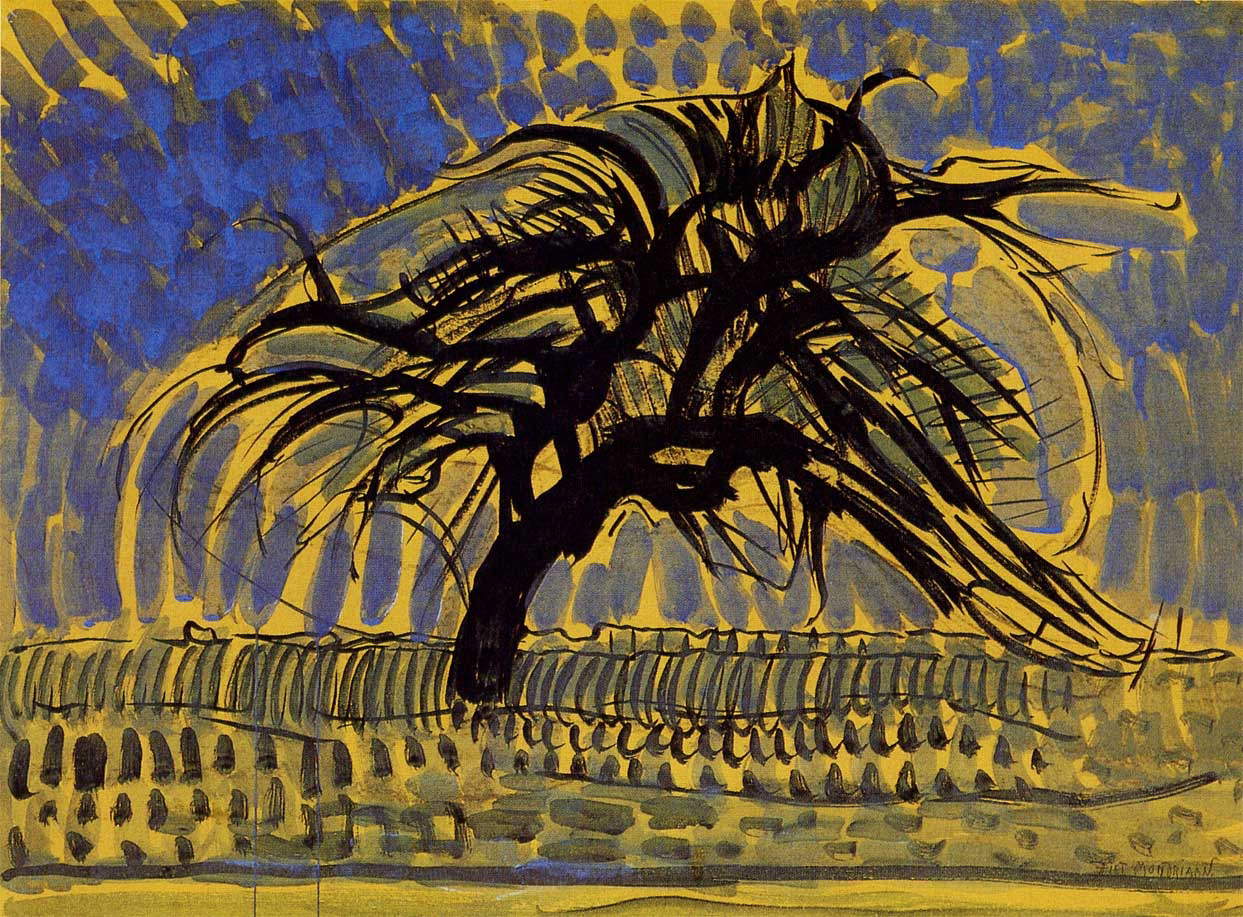 |
| Piet Mondrian, Blue Tree (c. 1909; tempera on cardboard, 75.5 x 99.5 cm; The Hague, Kunstmuseum Den Haag) |
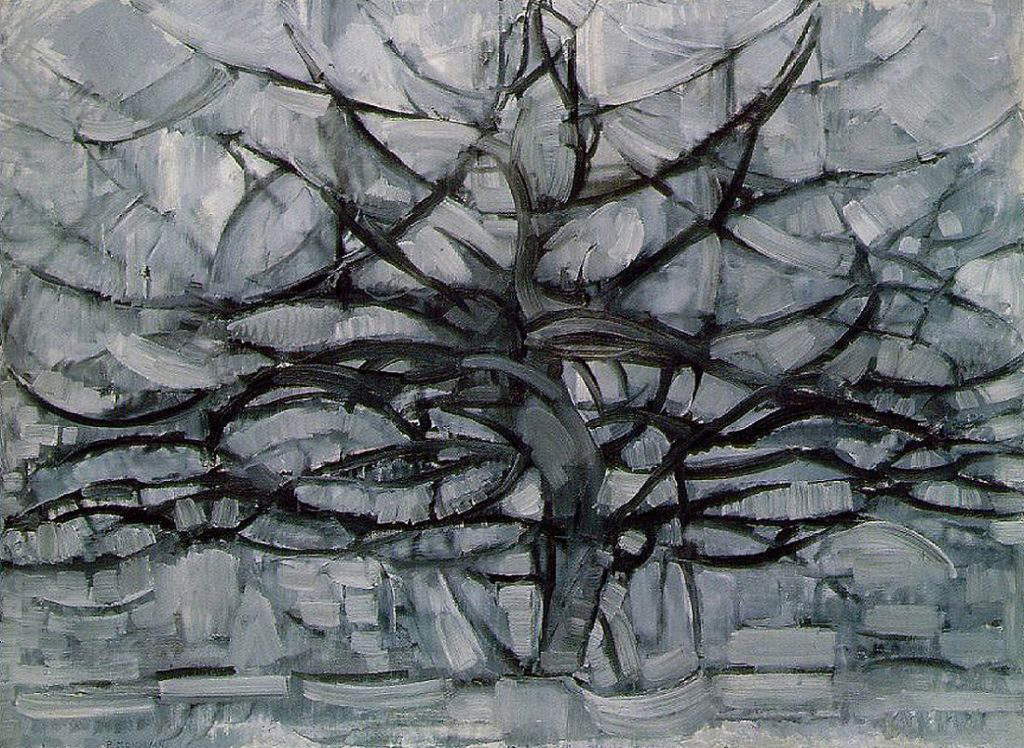 |
| Piet Mondrian, Gray Tree (1911; oil on canvas, 79.7 x 109.1 cm; The Hague, Kunstmuseum Den Haag) |
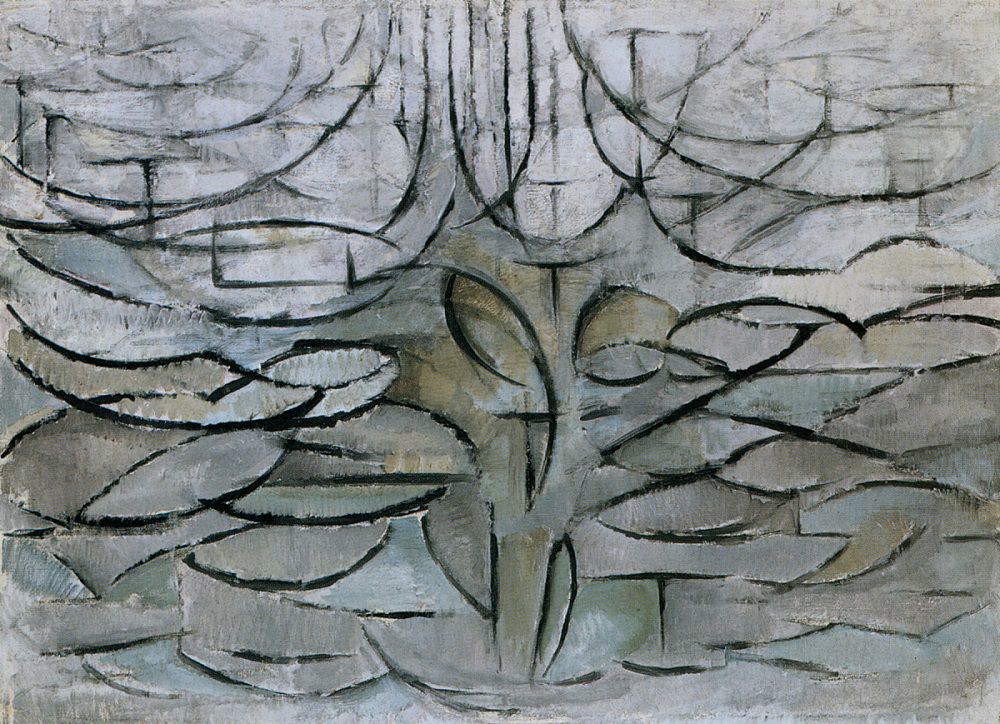 |
| Piet Mondrian, Apple Blossom (1912; oil on canvas, 78.5 x 107.5 cm; The Hague, Kunstmuseum Den Haag) |
The tendency to rectify curves proceeds with a painting such as Composition 3, where the curvilinear form of branches and leaves is still reduced into short segments that, especially at the top, now take on a straight line, before finally disappearing in Oval Composition with Planes of Color 2: both are paintings from 1914. Note how Mondrian introduces the shape of the oval, as if to balance the progressive geometrization of the painting’s elements and their reduction into vertical and horizontal structures by inscribing everything, however, in an oval (a solution that the artist would soon leave behind anyway). A painting such as Composition in Blue, Gray and Pink, also made in 2014, also sanctions the renunciation of curved lines: the chromatic element remains to be overcome, still firmly tied to the reality that Mondrian wants to transcend. A further turning point is provided by Composition No. 10 (Pier and Ocean), which Mondrian painted in 1915, upon his return to Holland (the artist had in fact left France at the outbreak of World War I). Here, the landscape is reduced to extreme synthesis: the piers, inspired by those the artist saw in Domburg, are simple crosses, and the ocean is nothing but a white, still oval expanse. This is the Dutch artist’s most extreme work at this point in his career (although, curiously, the title still does not resolve the painting’s connection to reality).
The last important juncture on the path to neoplasticism is the meeting in 1917 with a great compatriot, Bart van der Leck (Utrecht, 1876 - Blaricum, 1958), with whom Mondrian founded the magazine De Stijl and from whom he borrowed the use of only primary colors in composition, which Van der Leck had already been practicing for some time, although in paintings where the figurative component was still dominant: the Utrecht artist had in fact arrived at a procedure (he called it doorbeelding, a term that could be translated as “decomposition”) through which his figures came to the minimum terms (i.e., in vertical, horizontal or oblique strokes of different sizes), while retaining an organic and iconic, recognizable arrangement. That between Mondrian and Van der Leck was an exchange as equals: Mondrian was fascinated by Van der Leck’s chromatics, and the latter was instead attracted to the world in which Mondrian intended to employ the plastic elements of painting to arrive at abstract compositions. It was thanks to Mondrian that Van der Leck took to calling his paintings “compositions,” and embarked on the path of abstraction.
On Mondrian’s part, one of the earliest attempts to reduce even chromatics to flat, pure colors is Composition No. 3 with Planes of Color of 1917, an attempt to place different areas of color (although the painter had not yet reached the purity of primary colors, preferring more muted hues), juxtaposed according to logics of free aggregation. This is the hallmark of the Mondrian of these years: the next step is the rigid regulation of the areas of color into geometric shapes, as is the case in Composition with Grid 9: a brightly colored checkerboard composition, a 1919 painting that treasures the lesson of Van der Leck, and which also caused a stir when it was exhibited for the first time in Amsterdam in 1920: even, in a review that appeared in a Dutch newspaper it could be read that “the farthest thing from the idea of painting that we have, is Piet Mondrian’s painting.” Yves-Alain Bois, one of Mondrian’s leading experts, wrote that “the modular grid is purely self-referential, its configuration perfectly maps the field in which it is inscribed: it is an indicative sign, similar to a footprint in the sand. But it is still a static element (a grid is a grid): there is no precarious balance, no balancing act.” To achieve a new tension, it was therefore necessary to move away from the logic of the grid, which happens with Composition with Red, Blue and Yellow-Green of 1920, the final step before arriving at the 1921 works such as Composition with Large Red, Yellow, Black, Gray and Blue Plan that mark the beginning of the best-known phase of Mondrian’s career, that of accomplished neoplasticism, which is expressed through compositions made of black lines on white fields that, with great compositional freedom, delineate areas that Mondrian fills with pure primary colors, or in some cases leaves blank, always seeking the right balance between color, black and white.
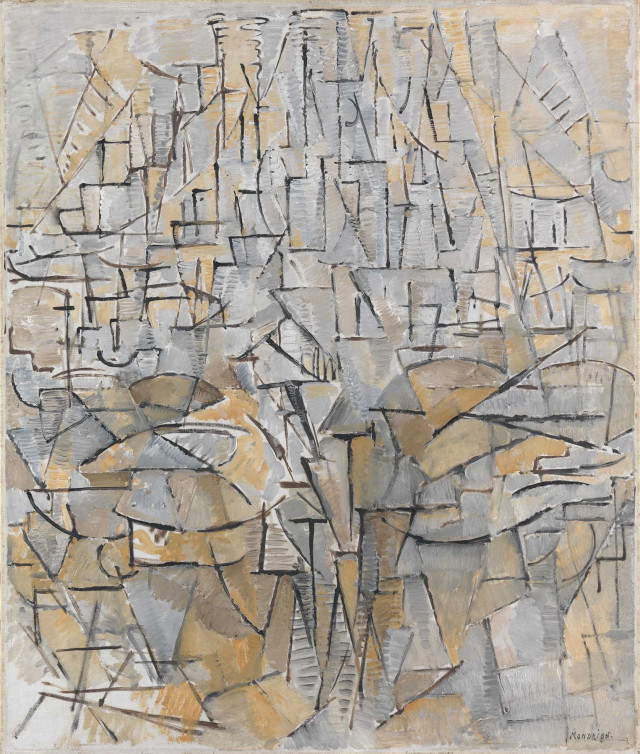 |
| Piet Mondrian, Composition No. 3 (1913; oil on canvas, 95 x 80 cm; The Hague, Kunstmuseum Den Haag) |
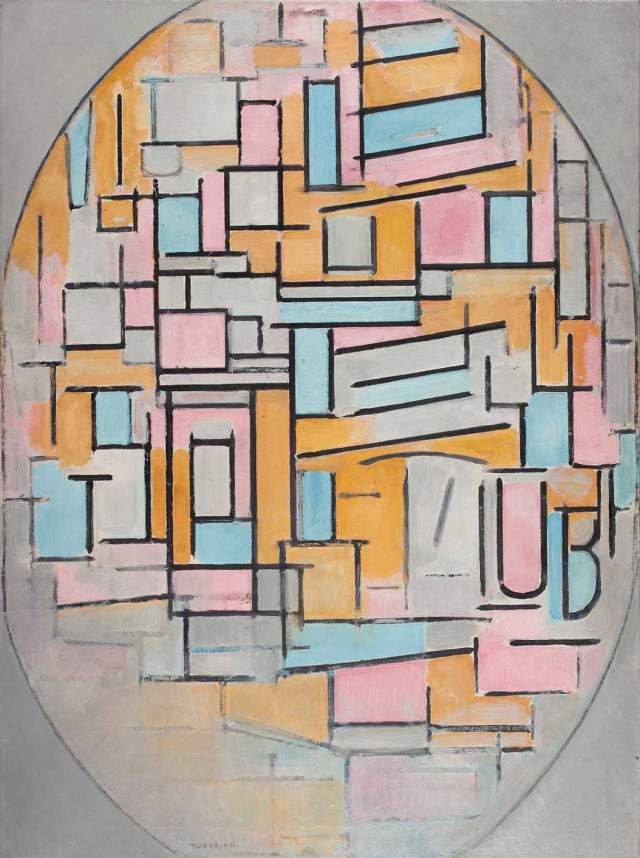 |
| Piet Mondrian, Oval Composition with Planes of Color No. 2 (1914; oil on canvas, 113 x 84.5 cm; The Hague, Kunstmuseum Den Haag) |
 |
| Piet Mondrian, Composition No. 10 (Pier and Ocean) (1915; oil on canvas, 85 x 108 cm; Otterlo, Kröller-Müller Museum) |
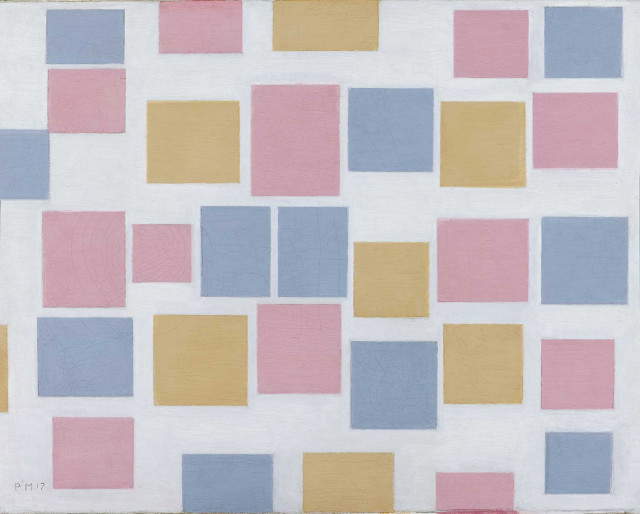 |
| Piet Mondrian, Composition No. 3 with Planes of Color (1917; oil on canvas, 48 x 61 cm; The Hague, Kunstmuseum Den Haag) |
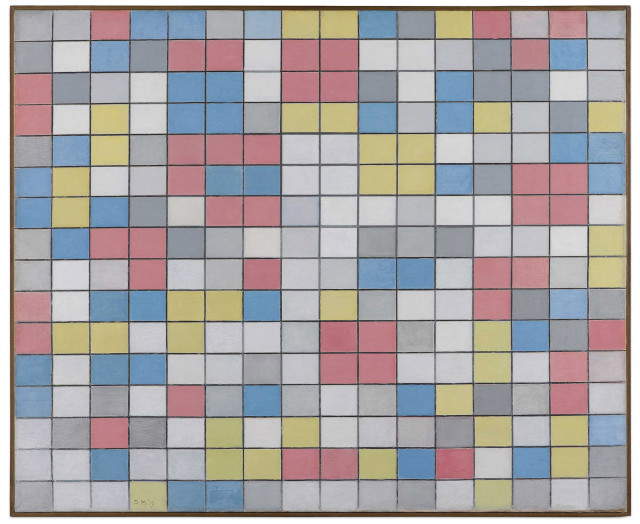 |
| Piet Mondrian, Composition with Grid 9: brightly colored checkerboard composition (1919; oil on canvas, 86 x 106 cm; The Hague, Kunstmuseum Den Haag) |
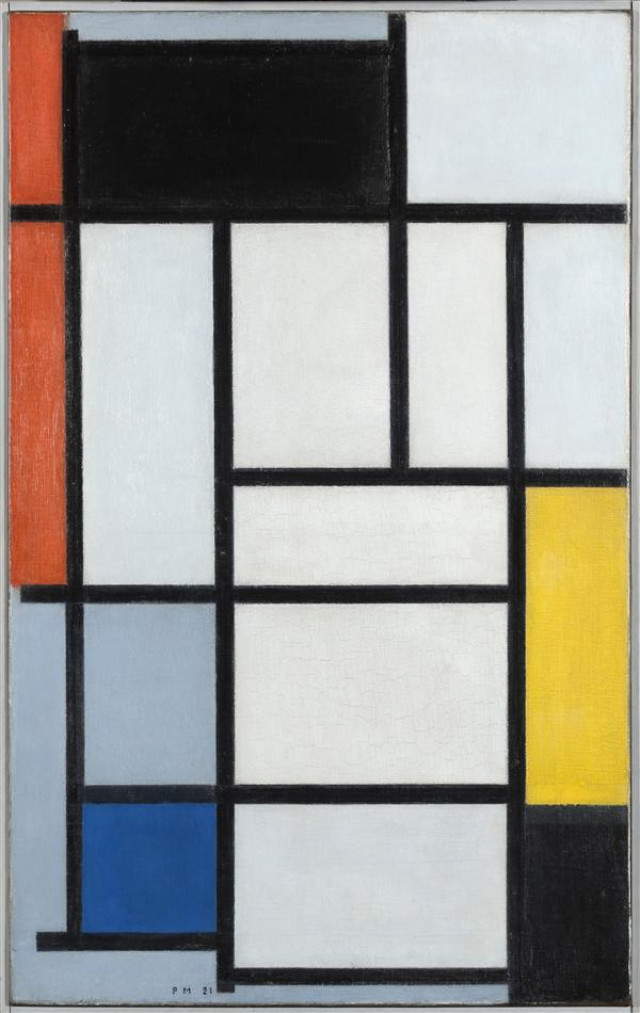 |
| Piet Mondrian, Piet Mondrian, Composition with Red, Black, Yellow, Blue and Gray (1921; oil on canvas, 80 x 50 cm; The Hague, Kunstmuseum Den Haag) |
With these compositions, Mondrian had achieved the goals he had been chasing for some time. A few passages from an important article, entitled De nieuwe beelding in de schilderkunst (“The New Image in Painting”), which the artist (who was also a fine and prolific theorist, though often repetitive) published in De Stijl in 1918, may be preface: “the life of modern, educated man,” the artist wrote, “is gradually moving away from the natural: it is becoming more and more abstract. [...] The life of the truly modern man is not focused by the material nor is it dominated by feeling, but presents itself as a more independent life of the human spirit becoming conscious. Modern man, a unity of body, soul and spirit, demonstrates a changed consciousness: all expressions of life take on a different aspect, and it is a more abstract aspect. This is also true of art: it begins to express itself as a product of a new duality (i.e., as a product of an educated exterior and a deeper, more conscious interiority), as a pure image of the human spirit, and expresses itself according to purely aesthetic visual forms, in an abstract aspect.” What Mondrian meant was that art, which until then had remained, in his view, a purely descriptive (and, consequently, individual) mode of expression, should seek to grasp the universal, to come as close to it as possible: “the new spirit,” he would write in Le néo-plasticisme: principe général de léquivalence plastique of 1920, “destroys the delimited form in aesthetic expression, and reconstructs an equivalent appearance of the subjective and the subjective, of the content and the containing: a balanced duality of the universal and the individual, and with this duality in plurality creates the purely aesthetic relationship.”
And this universality was expressed in a search for simplicity and essentiality, a theme that was moreover highly topical in the years immediately following World War I (one feels the drama of the time when, again in his 1920 writing, Mondrian states that “imbalance is a curse on humanity”). Neo-Plasticism was the art form that responded to this need, so called because Mondrian’s intent was to refound plastic expression: a “pure plastic expression” versus “descriptive expression,” to borrow the terms of the opposition used by the artist himself. An art poised between order and disorder, an art in search of the balance between duality that constitutes the main problem of Mondrian’s painting, and where lines, colors, and voids (which always remain independent elements in his compositions) are entrusted with the task of expressing the different tensions of the forces of life.
Reference bibliography
Warning: the translation into English of the original Italian article was created using automatic tools. We undertake to review all articles, but we do not guarantee the total absence of inaccuracies in the translation due to the program. You can find the original by clicking on the ITA button. If you find any mistake,please contact us.